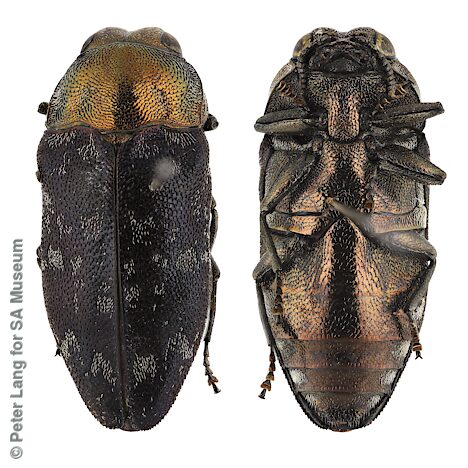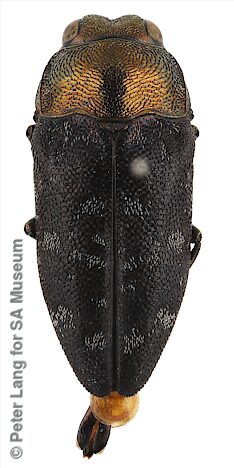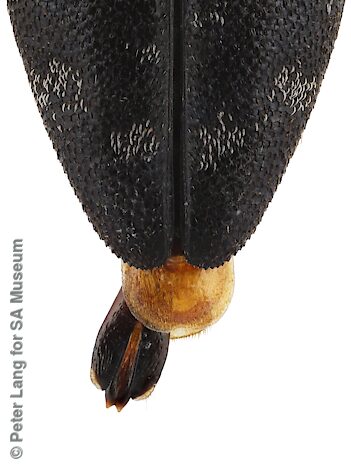


size¹:
×
3.3 mm



| male | female | |||||
|---|---|---|---|---|---|---|
| L1 | 7.5 | 6.9 – 7.9 | n = 3 | 8.0 | 7.75 – 8.4 | n = 3 |
| L2 | 7.3 | 6.8 – 7.75 | n = 3 | 7.8 | 7.6 – 8.25 | n = 3 |
| W | 3.2 | 2.9 – 3.45 | n = 3 | 3.4 | 3.35 – 3.6 | n = 3 |
| Legend | L1 | length from clypeus/frons to elytral apex (mean, range, sample size) |
| L2 | length from anterior of edge of eyes to elytral apex | |
| W | maximum width with elytra fully closed |
Head with frons deeply depressed; pronotum metallic, coppery to bronze-gold in both sexes; elytra black, with a prominent humeral protrusion and somewhat irregularly shaped whitish scale-hair patches. Larger and broader in shape than D. adusta, scutellum with more numerous and conspicuous puncta; aedeagus more cuneate in shape, with transparent apical margins on the parameres longer and more transverse, and the centromere apically bidentate with the inner margins on each half inclined.
Only known in SA from a single early collection comprising six specimens from Quorn in the southern Flinders Ranges. These specimens, housed in the SA Museum, are from the Blackburn collection and would have been made well over a 100 years ago. They are a good match with eastern Australian specimens of D. cupreola and were designated as paratypes by Barker 2001.
Collections of D. adusta from the MU and EP regions were confused with D. cupreola on this website until January 2023, although qualified by a note that they "approach D. adusta in their smaller size and more subdued colouration and the separation of these species needs further investigation".
The two species are actually quite distinct and differ in many characters, including details of their male genitalia.
| Legend | P.J.Lang collection vouchered records | |
| other private collection or museum specimens, or sightings |
Barker 2001 cites four males collected from Sallow Wattle (Acacia longifolia) in the upper Blue Mountains, NSW.
| ¹ Legend | regions | SA State Herbarium regions (map) EA: Eastern, EP: Eyre Peninsula, FR: Flinders Ranges, GT: Gairdner-Torrens, KI: Kangaroo Island, LE: Lake Eyre, MU: Murray, NL: Northern Lofty, NU: Nullarbor, NW: North-Western, SE: South-Eastern, SL: Southern Lofty, YP: Yorke Peninsula |
| size | The ellipse is the correct size when printed, indicative on a desktop screen, and likely to be wrong on a mobile device. |